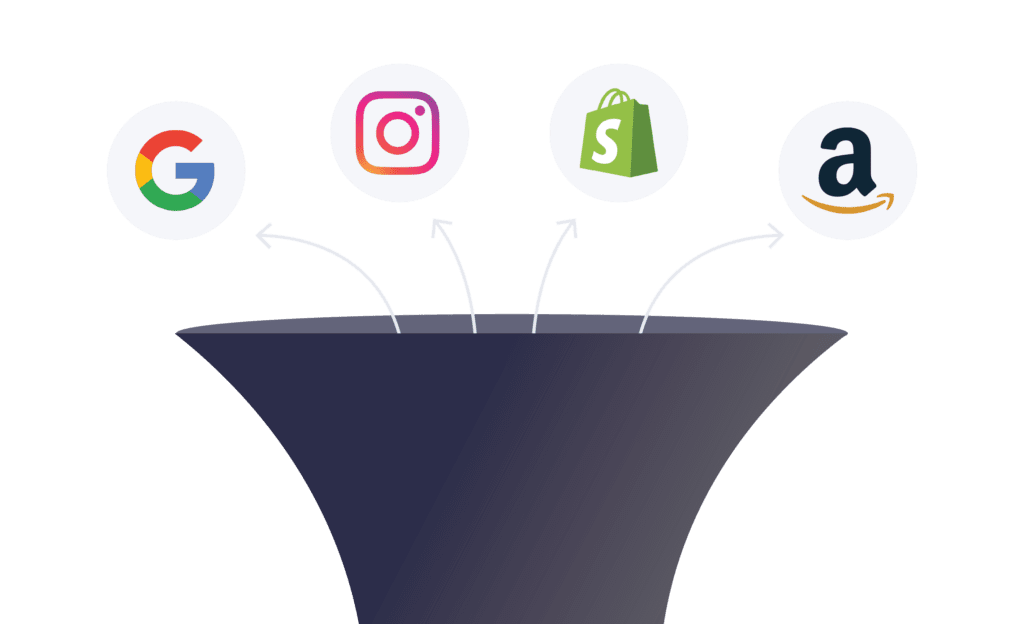Looking to diversify your ecommerce sales channels? This guide to multichannel ecommerce covers everything from marketplace recommendations to multichannel fulfillment strategies.
What is multi-channel eCommerce?
Multichannel ecommerce is an online sales tactic that involves selling products through multiple platforms online including marketplaces such as Amazon and eBay, a dedicated ecommerce website, and social media. Merchants looking to gain more exposure and decrease their dependence on a single revenue stream should consider adding new sales channels to their ecommerce strategy.
The following guide outlines the benefits of multichannel ecommerce as well as practical strategies for success for businesses of all sizes.
- The Rise of Multichannel eCommerce
- eCommerce Sales Across Online Marketplaces
- eCommerce Fulfillment Across Multiple Marketplaces
- Simplifying eCommerce Sales with Technology
- Multichannel eCommerce Fulfillment: Cost Center or Revenue Driver?
- Strategies for eCommerce Inventory Management
1. The Rise of Multichannel eCommerce
The truth is, your best customers aren’t always looking for you, which means you have to meet them in the places they’re already shopping. Today’s shoppers have endless options when it comes to where and how to make their purchases, beginning with their initial product search. With new enhancements to Google Shopping, consumers can search, browse, and purchase without even navigating away from their search engine.

Increasingly, shoppers are confronted with purchase opportunities when they aren’t even actively shopping. “Buy” buttons on Facebook, Twitter, and Pinterest allow for in-app purchases that hardly disrupt the social media browsing experience. And between swipe up to shop ads and shop-able posts, Instagram is blurring the line between marketplace and social media network. YouTube is even experimenting with new shopping features that would allow creators to tag products in their video for purchase opportunities.
And social media is only the tip of the iceberg. The world of ecommerce is also populated with multiple marketplaces, ecommerce storefronts, and subscription services. This fast ecosystem of digital sales channels has made shoppers accustomed to brands coming to them — meeting them where they’re already shopping, rather than trying to make them navigate away to another channel.

Even the best marketer can only drive so much traffic through a single sales channel, and whether your current primary channel is a brick and mortar store, an online marketplace, or your own eCommerce site, adding more digital sales channels will:
- Expose shoppers to your brand in multiple stages of the buyer journey
- Increase general brand awareness
- Drive more traffic to all of your channels
- Grow your digital footprint
- Increase ROI on your ad spend
Adopting a multichannel selling strategy reduces risk and drives revenue and specific advantages of each channel approach from traditional to digital.
2. eCommerce Sales Across Online Marketplaces
Online marketplaces are a great first step to branching into multichannel sales for several reasons, including:
- They’re simple to launch and maintain
- They require little to no upfront investment
- They offer significant SEO and SEM advantages
- They attract high-intent shoppers
There are endless marketplace options for merchants to choose from in today’s highly digitized economy, and each offers a different community of shoppers and a unique buying experience. Understanding the differences between these marketplaces and how your products fit into their existing structure will help you focus your energy on the best fit marketplaces for your business. We’ve outlined some of today’s most popular marketplaces to begin your multichannel ecommerce journey.
- Amazon is the world’s largest and most high-traffic online marketplace, making it both a great opportunity and a competitive battleground for third-party sellers.
- eBay remains one of the largest online marketplaces, but unlike Amazon doesn’t compete with third-party sellers. Their Fast & Free program, similar to Prime, attracts loyal, high-volume shoppers, but there is no internal fulfillment program to support it. Sellers looking to qualify for Fast & Free will have to find their own fulfillment solution.
- Walmart Marketplace is vying for Amazon’s first place position with expanded ecommerce options and the recent introduction of Walmart+. It’s extensive network of brick and mortar stores give it a distinct advantage for convenient returns and immensely popular BOPIS (Buy Online Pick Up In Store) delivery options.
- Newegg began as a tech-only marketplace. It has since expanded its product offerings but still primarily attracts tech-savvy consumers. It’s membership program Newegg Premiere encourages customer loyalty and higher AOV (average order value) for sellers who can meet their 3-day shipping standard.
- Overstock is still primarily known for furniture and home goods offerings but has expanded into various product categories. It attracts shoppers who are looking for great deals on high-quality items.
What is Multichannel Listing?
Multichannel listing refers to the process of uploading and managing product listings across multiple channels. Managing multiple product listings gets complicated with the varied requirements — from content formatting to pricing — of each channel. Most multichannel merchants use a multichannel listing software to automate many of the day to day processes of managing multiple listings.
Can You Sell on Multiple Platforms?
Beyond selling on multiple marketplaces, you should also consider opening up your listings to even more diverse platforms. Selling on social media or an ecommerce site powered by a shopping cart like Shopify or BigCommerce gives you more control over your brand and direct interaction with your customers. Restrictions like Amazon’s Fair Pricing Policy may make some merchants wary of listing items on multiple platforms, but a multichannel listing with automatic repricing can help maintain compliance across all sales channels.
3. eCommerce Fulfillment Across Multiple Marketplaces
Though you want to be sure to focus your efforts on the best-fit marketplaces for your brand, overwhelmingly, the evidence suggests that simply listing on one marketplace is not enough. According to multi-channel selling software, Sellbrite, merchants who are listed on 3 or more marketplaces see an average of 156% higher sales compared to those listed on only one.

The prospect of managing product listings, sales, and fulfillment across multiple marketplaces may be overwhelming for SMB’s in the early stages of launching their multichannel ecommerce strategy. This simple guide outlines how to sell on multiple marketplaces with tips on:
- Leveraging community around your brand: Understand why consumers are drawn to your brand and capitalize on those features. Tailor your product photos and descriptions to capture the attention of shoppers in a crowded marketplace, and engage with your customers through comments and reviews both on the marketplace platform and social media.
- Automating as many internal processes as possible: Automate listings and product photos, keeping them all compliant with each marketplace’s standards with a multichannel selling software. Automatic repricing features will make sure you stay at the top of the search results without cutting into your margins.
- Integrating sales with fulfillment: Your sales channels are digitally optimized, and your fulfilment operations should be too. Choosing an outsourced fulfillment partner that integrates seamlessly with your digital sales channels will be key to making fulfillment a growth lever in your multichannel strategy.
- Streamlining fulfillment across multiple marketplaces: Some merchants choose a piecemeal approach to their multichannel fulfillment by using each marketplace’s in-house fulfillment solution. However, streamlining fulfillment through a one provider will allow flexibility between marketplaces and give you full insight into fulfillment and delivery statuses through a single dashboard.
Simultaneously leveraging multiple marketplaces will not only compound growth but will lower your risk in the event of any marketplace failure due to increased competition, losing a Prime (or similar) seller status, or technical failure. This multi-threaded approach will not only bullet-proof your multichannel selling strategy but will diversify your audience and give you the confidence to expand into new markets with less risk.
4. Simplifying eCommerce Sales with Technology
The requirements for effectively managing multiple sales channels are not only rigorous but are constantly changing. If you’re selling across multiple sales channels to expand your market share and brand presence, a multichannel selling software can be a valuable asset that allows you to keep up with the demands of managing multiple channels without significantly scaling up your internal resources.
An effective multichannel selling software can help you:
- Build effective COM (Commerce Operations Management)
- View all channel metrics through a single dashboard
- Make strategic, data-driven decisions based on channel performance
- Launch new channels and products quickly
- Sync sales channels with fulfillment operations
As with any tool your business employs, it’s important that your multichannel selling software simplifies your operations and supports your long-term business goals and integrates seamlessly with any other technology platforms your business employs like your ecommerce shopping cart, payment processing, and fulfillment software.
5. Multichannel Ecommerce Fulfillment: Cost Center or Revenue Driver?
With each new channel you add to your multichannel selling strategy comes added complexity in supply chain and order fulfillment. Many marketplaces and sales channels offer their own fulfillment programs, but segmenting these processes across multiple providers does not allow for the visibility or flexibility needed for a quickly-growing business to compete.
Similar to managing multichannel listings with a multichannel selling software, the key to successful multichannel fulfillment is to integrate and automate wherever possible. For most SMB’s outsourcing fulfillment is the most sustainable and scalable solution. Choosing an outsourced fulfillment partner that prioritizes technology grants your business access to software solutions previously unavailable to SMB’s. Best-in-class fulfillment software will aggregate orders from all sales channels (both digital and traditional) and process any order type through a single platform.

This type of high-level visibility allows you to think strategically and proactively about your fulfillment processes. It not only simplifies your end to end supply chain but through automation, integration, and insights, makes fulfillment a growth driver across all sales channels. Meeting all customers, whether B2B or B2C, through ecommerce or in-store, with an exceptional delivery experience builds strong preference for your brand. According to a recent survey, 59% of merchants saw more repeat customers when offering 2-day delivery, and 39% saw better online reviews.
6. Strategies for eCommerce Inventory Management
Tracking inventory across multiple locations and through multiple sales channels can seem daunting, but it is not only manageable for businesses of all sizes, it can become part of your multichannel growth strategy. A strategic inventory management system can mean the difference between feeling like you’re always struggling to stay one step ahead of demand and leveraging inventory for future growth, even with limited investment in fixed assets.
As with all aspects of a multichannel selling strategy, the name of the game for successful inventory management is integration and automation. Having inventory fully integrated with all sales channels allows for a high level of visibility, which in turn allows for strategic rather than reactive action. A strategic inventory management system may include:
- Setting automatic reorder points to reduce costly stockouts
- Analyzing historical sales data to identify seasonal trends and forecast demand
- Planning sales and promotions with confidence that your supply chain will meet the increase in demand
- Determine ideal inventory carry costs depending on your risk tolerance for stockouts and capital investment
- Ring your inventory to feed your highest-performing channels
These advanced functions are achievable for merchants of all sizes through strategic partnerships and will position any business for exponential growth when leveraged together. Take a deeper dive into some multichannel inventory management tactics to learn how your business can transform inventory into a growth lever.



